Recent Articles
Popular Makes
Body Types
2025 Honda Civic Hybrid Road Test and Review
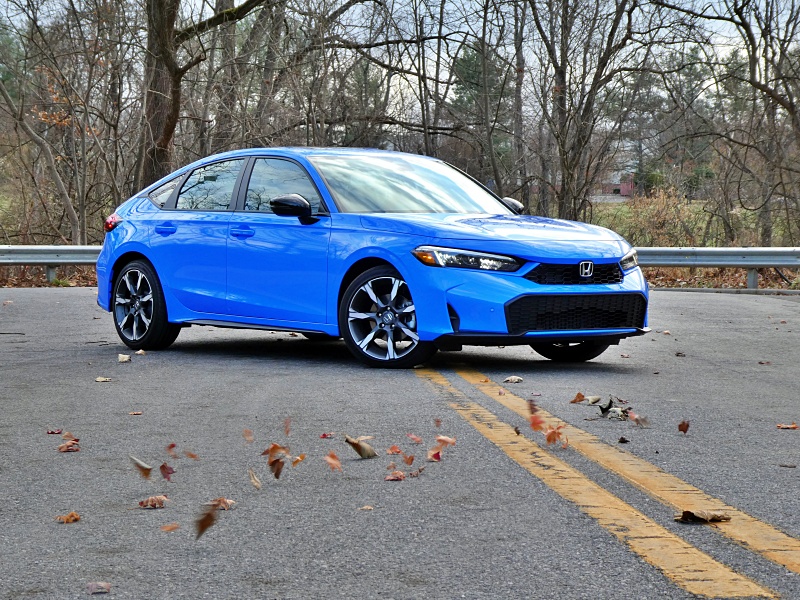
2025 Honda Civic Hybrid Sport Touring hatchback ・ Photo by Brady Holt
Everybody knows about the Toyota Prius, the first hybrid to become a smash hit in America. But another gas-electric compact car also appeared soon after the Prius – the 2003 Honda Civic Hybrid. After years of mild popularity as an economical but slow and expensive sedan, the Civic Hybrid eventually disappeared after the 2015 model year. Honda tried something similar with the Insight sedan – a Civic-based hybrid sold from 2019 to 2022 – but it didn’t take off, either.
Now, for 2025, the Honda Civic Hybrid is back. But it’s not a slow sedan with great mileage. It replaces upper-trim Civics’ old turbocharged engine as the powerhouse of the Civic lineup – and it gets great gas mileage. It’s also available for the first time as a five-door hatchback in addition to a four-door sedan, creating a closer rival to the iconic Prius. We just spent a week testing the new Civic Hybrid hatchback to learn more about its pros and cons. Keep reading to find out what we learned and whether it’s the right fuel-sipping small car for you.
The Top of the Civic Lineup
On the Honda Accord sedan and CR-V crossover, hybrids now sit at the top of the lineup. They have the quickest acceleration as well as the best fuel economy, and they’re paired with the most features. The new 2025 Civic Hybrid follows this same approach – you can’t get a stripped-down Civic Hybrid or a top-of-the-line non-hybrid Civic.
The 2025 Civic Hybrid starts at $28,750 in sedan form and $29,950 as a five-door hatchback. That compares with $24,250 for the cheapest Civic: the LX sedan with a gas engine. However, if you upgrade to the Civic Sport (the next-up sedan and the base-model hatchback), it’s only a $2,500 savings versus the equivalent Civic Sport Hybrid. And in addition to the upgraded powertrain, that money buys you a sunroof, heated front seats, and variable intermittent windshield wipers. The other Civic Hybrid trim level is the Sport Hybrid Touring like our test vehicle. It adds leather upholstery, a power driver’s seat, a wireless smartphone charger, a 12-speaker stereo, and a bigger infotainment touchscreen. It costs $31,750 for a sedan and $32,950 for a hatchback.
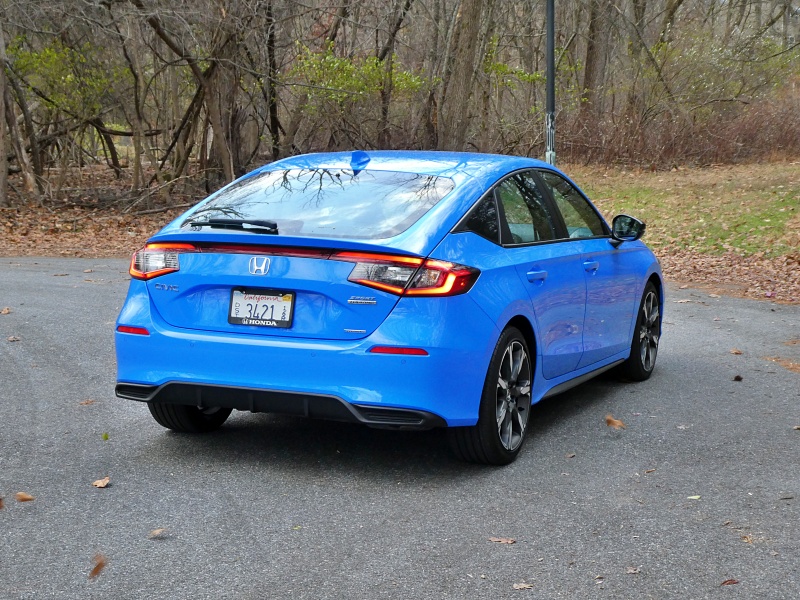
2025 Honda Civic Hybrid Sport Touring hatchback ・ Photo by Brady Holt
Up to 50 Miles Per Gallon
Hybrids use an electric motor to take some burden off a gasoline engine, which saves fuel. The Civic Hybrid’s engine can shut off entirely in certain conditions, like idling, coasting, or even accelerating gently. Using the running engine plus recaptured energy from braking friction, the Civic Hybrid can recharge its small battery while you drive.
Thanks to this technology, the Civic Hybrid gets EPA estimates of 50 mpg in the city, 47 mpg on the highway, and 49 mpg combined as a sedan, while the hatchback like our test vehicle gets 50 mpg city, 45 mpg highway, and 48 mpg combined. That compares with about 31 mpg city, 39 mpg highway, and 34 mpg combined for most gas-powered Civics – meaning that you’d see a particular advantage in low-speed and stop-and-go driving.
Our test vehicle delivered mixed results during our weeklong test. On the one hand, it averaged only about 43 mpg during five days of mixed driving in subfreezing weather – well below the EPA estimate. However, it managed 57 mpg in a shorter stretch of highway, suburban, and rural conditions while temperatures were in the 50s. And in that same mild weather, we coaxed the Civic Hybrid to 83 mpg across 20 miles of looping slowly around a suburban residential neighborhood. You probably won’t drive it that way for so many miles, but the experiment illustrates how well the Civic Hybrid can perform in certain circumstances.
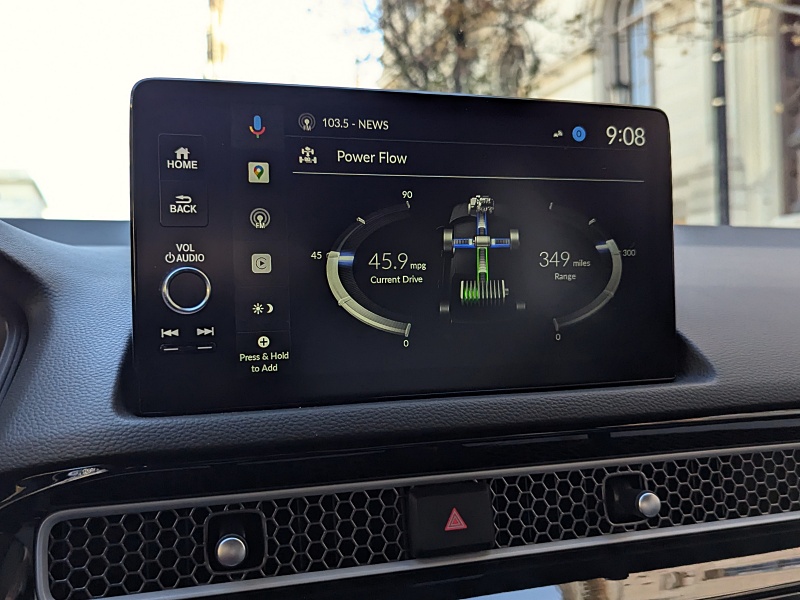
2025 Honda Civic Hybrid Sport Touring hatchback ・ Photo by Brady Holt
It's Got Moves, Too
The Civic Hybrid’s immediate predecessor, the 2022 Honda Insight sedan, got even better mileage – up to 55 mpg city, 49 mpg highway, and 52 mpg combined. The difference is that unlike the Insight, the Civic Hybrid is a blast to drive.
It starts under the hood. Rather than using an electric motor to replace some of a gas engine’s output, the Civic Hybrid uses it as a bonus. In total, it makes 200 horsepower and 232 lb-ft of torque – among the highest outputs of any compact mainstream-brand car. Even the Civic Si turbocharged performance model manages the same 200 hp but just 192 lb-ft. The base gas-only Civic has 150 hp and 133 lb-ft of torque, and the 2022 Insight had 151 hp and 197 lb-ft.
More than just the numbers, this engine has a spunk that we didn’t find in the Insight. This Civic is not only eager to zip forward, but it makes a quiet growl rather than the labored drone you’d find in the old Insight (or in a Toyota Prius). Everything feels so natural, it’s easy to forget it’s a hybrid. We also appreciated the Civic Hybrid’s upscale ride and handling, with a firm yet composed suspension in either routine driving or a winding back road. It’s the perfect complement to the willing engine. Our chief complaint was a bit of excess road noise on the highway.
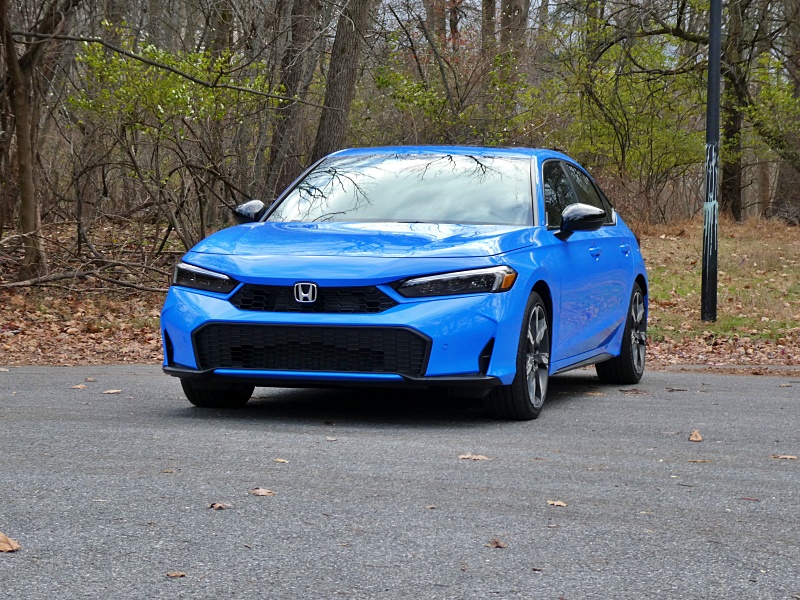
2025 Honda Civic Hybrid Sport Touring hatchback ・ Photo by Brady Holt
Freshened Design
In addition to its new hybrid option, every 2025 Civic gets updated exterior styling. We’re fans. The changes are subtle – the grille is now aligned with the headlights rather than being slightly lower, and there’s much less black plastic on the front bumper under the headlights. To us, the new look is so much better, we’re amazed Honda didn’t figure it out the first time when the current Civic body debuted in 2022.
Still, the Civic remains a conservative-looking vehicle. Our test vehicle’s Boost Blue paint means you won’t lose it in a parking lot, and the hatchback’s sloped rear end is sportier than the boxier sedan's. But you won’t find lots of flashy details. Some folks will welcome this restraint, while others will wish for something bolder – especially on the sedan.
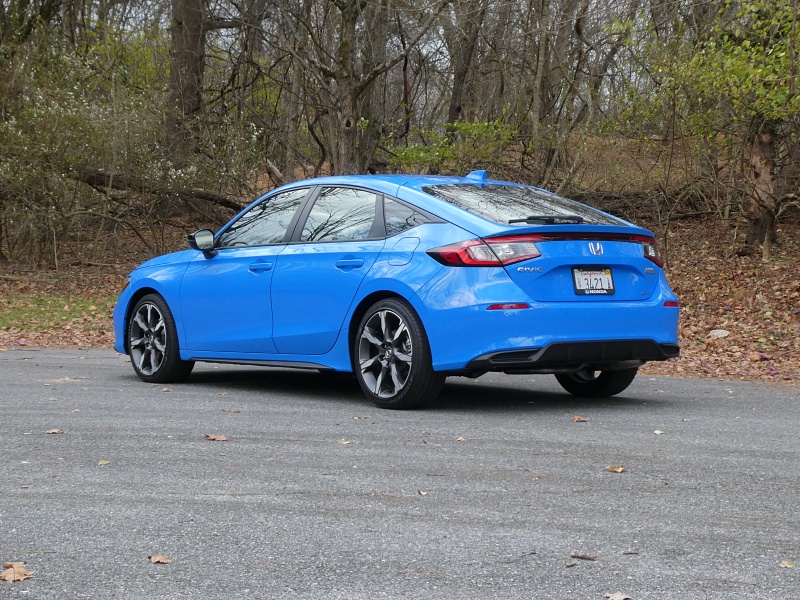
2025 Honda Civic Hybrid Sport Touring hatchback ・ Photo by Brady Holt
Upscale Simplicity Inside
Some of today’s budget-car interiors set out to dazzle you with big, bright screens; flashy shapes; and bright colors. That’s not the Civic. The Sport Hybrid has a tiny 7-inch infotainment touchscreen with extra-plain graphics, and even the Sport Touring Hybrid's 9-inch touchscreen is pretty muted. Every Sport has a black interior, while the Sport Touring gives you a choice of black or gray leather to pair with the black dashboard.
But we love the Civic for its exceptional build quality and extra-simple ergonomics. Buttons, knobs, and other moving parts operate with a precision you won’t find in some luxury cars. And you neither have to rely on a touchscreen nor hunt amid a sea of buttons. Honda also dresses up the dashboard with an intricate honeycomb strip that incorporates some of the dashboard vents. Our chief complaint is a small plastic area alongside the gear selector that’s prone to scratching easily. Otherwise, the Civic’s interior is top tier – at least for folks who don’t prefer more pizzazz or a more digital-focused experience.
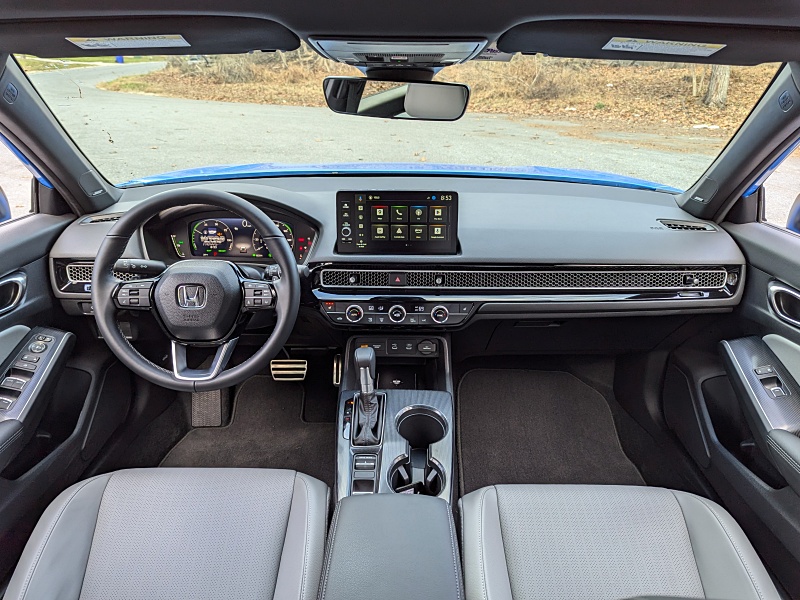
2025 Honda Civic Hybrid Sport Touring hatchback ・ Photo by Brady Holt
Who Needs an SUV?
The Civic Hybrid hatchback, like our test vehicle, is an exceptionally useful vehicle for an economy car. Its deep cargo hold provides 25 cubic feet of space behind the rear seat, which edges out the Honda HR-V crossover SUV. You can also fold the rear seat down to expand volume; while Honda doesn’t publish this spec, we estimate that you get at least 50 cubic feet in total behind the front seats. Once again, this number beats many subcompact crossovers (though not the HR-V). We also love Honda’s nifty retractable cargo cover, which deploys from the side of the car and isn't in your way when you fold the seats down.
The Civic Hybrid sedan is also roomy for what it is. Its trunk measures 15 cubic feet, better than most compact sedans. And because the Civic sedan is longer than the hatchback, it has a little more floor space when you’re not stacking your luggage high. But the hatchback is the true cargo champ for space and flexibility.
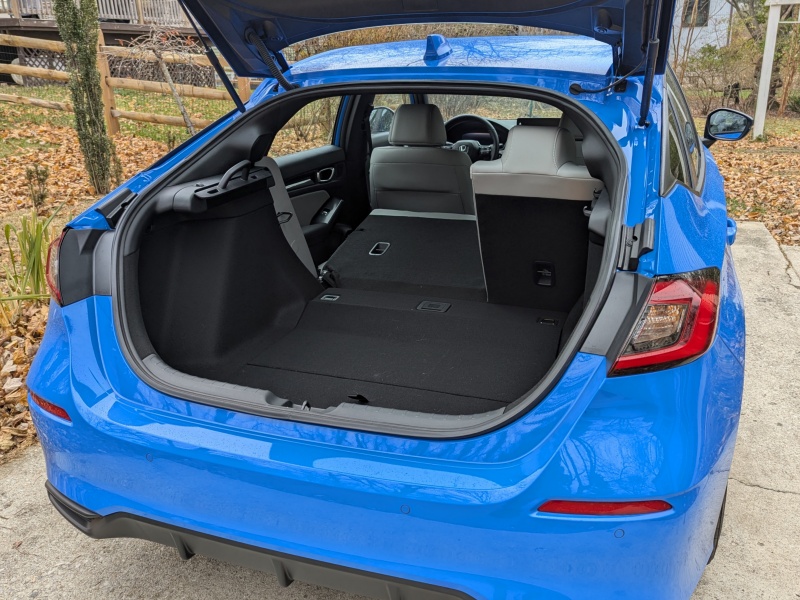
2025 Honda Civic Hybrid Sport Touring hatchback ・ Photo by Brady Holt
Roomy But Low Seats
While the Civic hatchback’s cargo capacity can rival an SUV’s, its seating position doesn’t. You sit low in the Civic, even by the standards of an economy car. That’s fun for people who prefer that sporty feel, but others will prefer the easier entry/exit and more commanding view they get in a crossover. We’re also disappointed that the Civic doesn’t offer a height-adjustable passenger seat, even on the top trim level.
The Civic is still roomy, though. Adults fit fine even in the backseat, making it a potential alternative to a bigger, more expensive mid-size car. If you feel too squeezed in the latest Toyota Prius, the Civic Hybrid is for you. Unlike on the Prius, though, you can’t get extra amenities like ventilated front seats or heated rear seats.
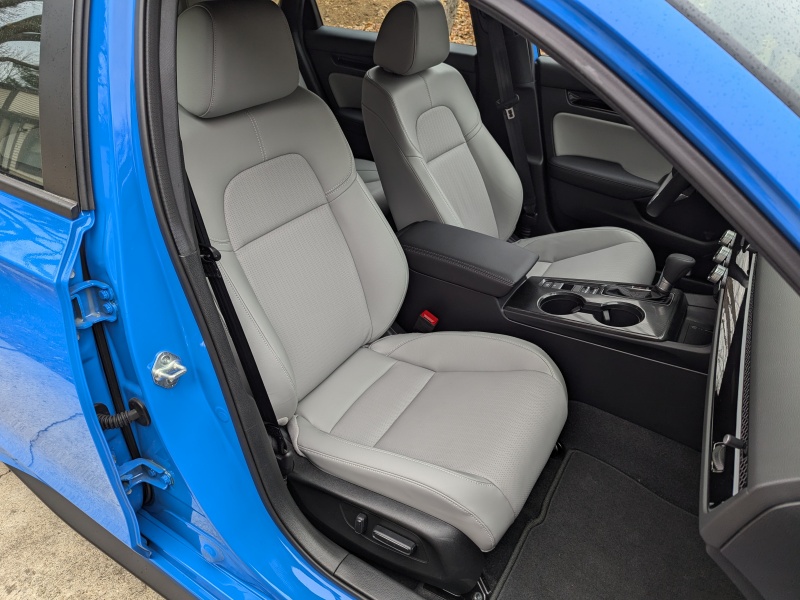
2025 Honda Civic Hybrid Sport Touring hatchback ・ Photo by Brady Holt
Competitors to Consider
Toyota recently won acclaim for its more stylish, more powerful Prius. The once-dowdy hybrid hatchback traded maximum mileage and extra interior room for more personality and performance. It packs more visual punch than the Civic Hybrid while still getting even better mileage: 52 mpg to 57 mpg in mixed driving, depending on the trim level, with front-wheel drive. Or you can option it with all-wheel drive – a feature not available on the Civic Hybrid – and give up about 3 mpg. You can also get the Prius as an extra-efficient plug-in hybrid, another option Honda doesn’t provide. On the other hand, the Civic Hybrid is quicker, quieter, and more fun to drive overall. It has more passenger and cargo room, and it has simpler controls.
Other top competitors are the Kia Niro, Hyundai Elantra, and Toyota Corolla hybrids. The Niro tall hatchback is the roomiest of the bunch, and it drives pretty well. But it’s not a fun-to-drive sporty vehicle like the Civic Hybrid – and it’s no more fuel-efficient. The Elantra and Corolla hybrids are sedans with less room, less sporty performance, and a lower-end feel than the Civic Hybrid sedan, but they’re also less expensive.
If you’re interested in the Civic Hybrid for its speed rather than just its mileage, you can also compare it against the Mazda3 Turbo and Volkswagen Golf GTI. These are polished, powerful small cars with crisp handling moves and plenty of power. The Civic Hybrid isn’t quite as zippy, but it comes close – while burning as little as half the fuel. And once again, the Honda stands out for its easy controls and roomy interior.
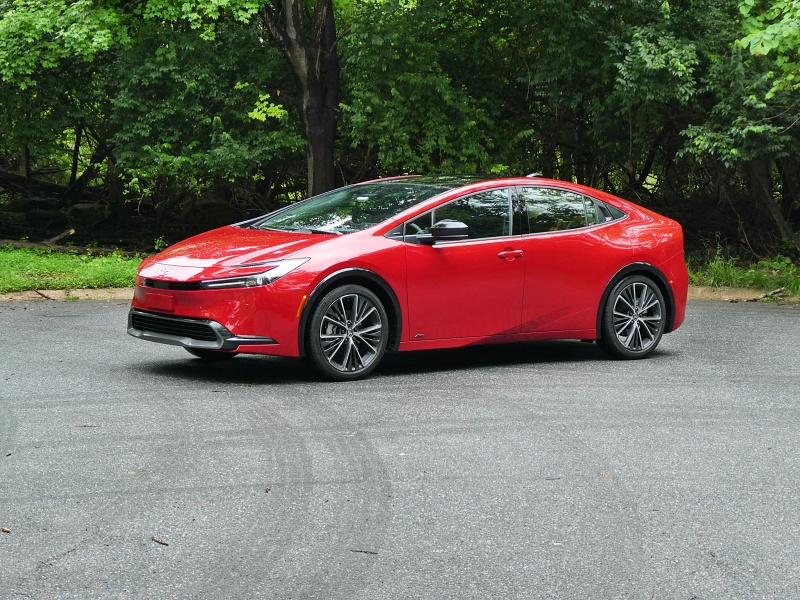
2024 Toyota Prius Limited ・ Photo by Brady Holt
Efficiency Without the Downsides
You can buy the 2025 Honda Civic Hybrid for its gas mileage, with its lively and sophisticated driving manners being icing on the cake. Or you can buy the 2025 Honda Civic Hybrid for its sporty performance and treat its fuel savings as the unlikely bonus. And in both cases, you’ll appreciate the roomy interior and well-sorted dashboard controls.
The Civic Hybrid doesn’t have the highest possible mileage, the lowest possible price, the longest possible list of amenities, the biggest possible dashboard screens, or the most charismatic styling. We understand if those are deal-breaking drawbacks for you. But we love the Civic Hybrid’s overall package – an affordable upscale sports compact with no-compromises efficiency. For a wide variety of potential owners, it’s a big winner.
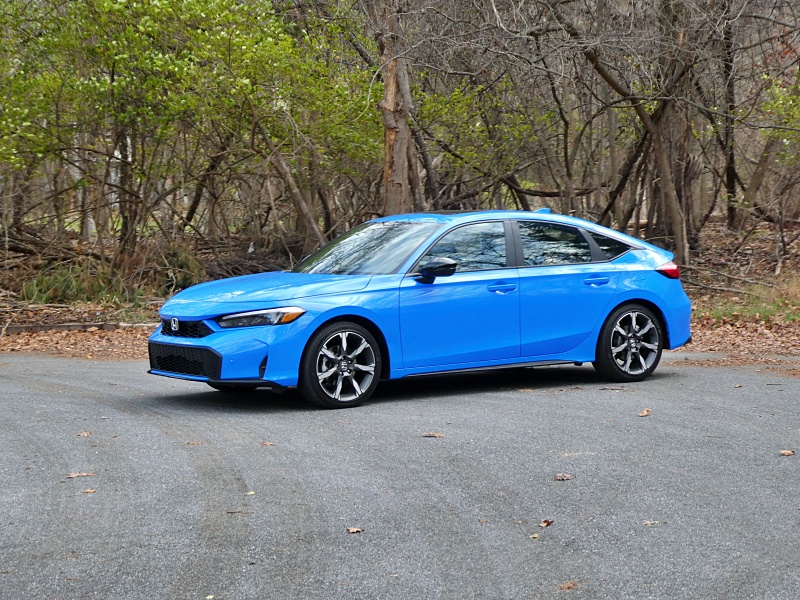
2025 Honda Civic Hybrid Sport Touring hatchback ・ Photo by Brady Holt